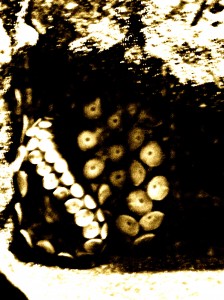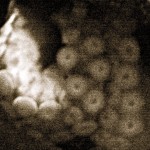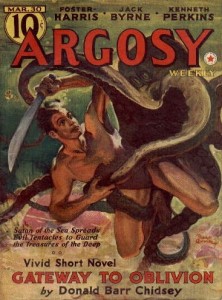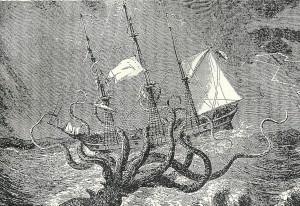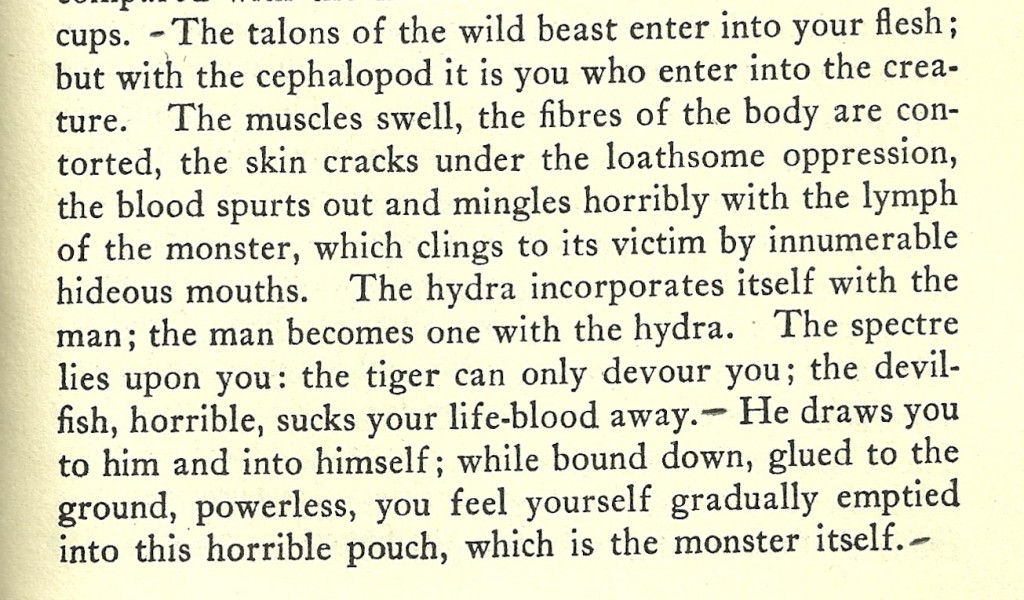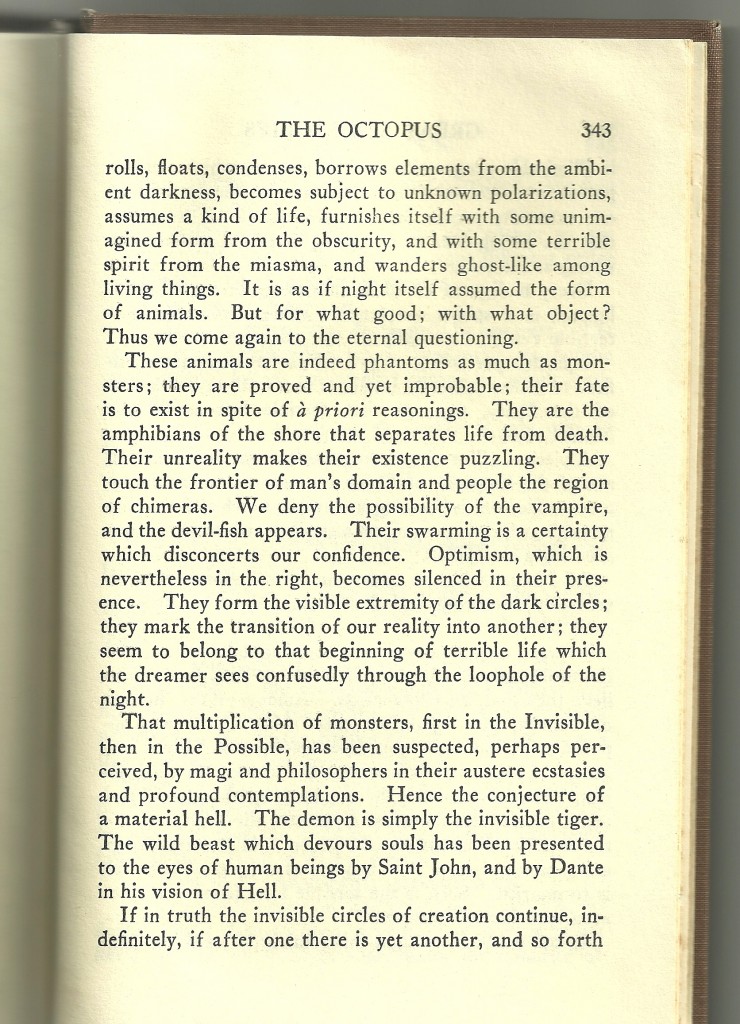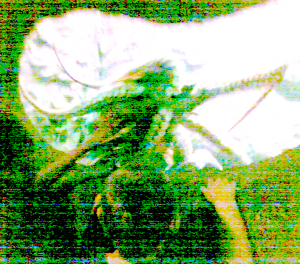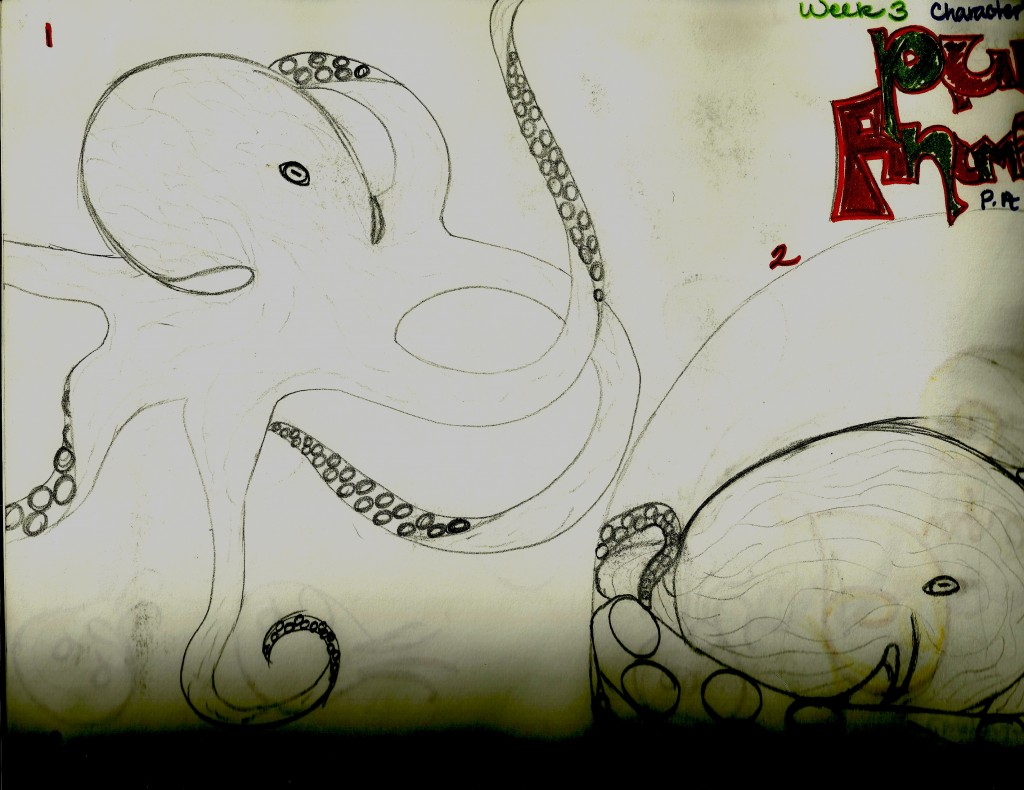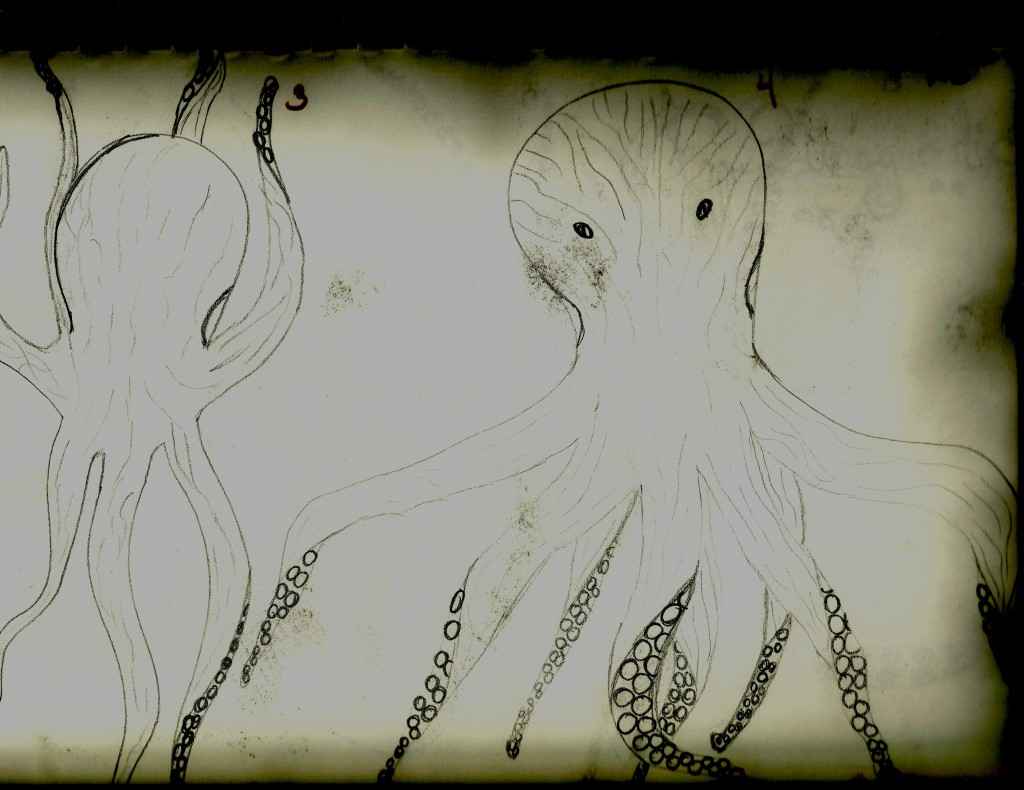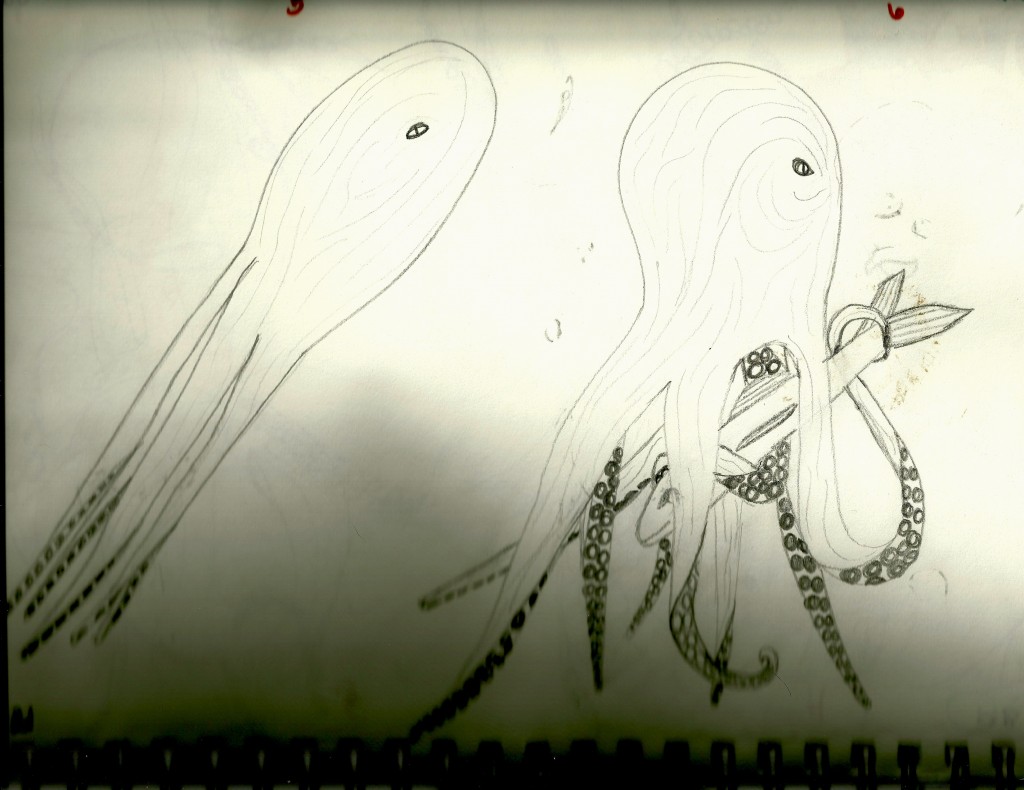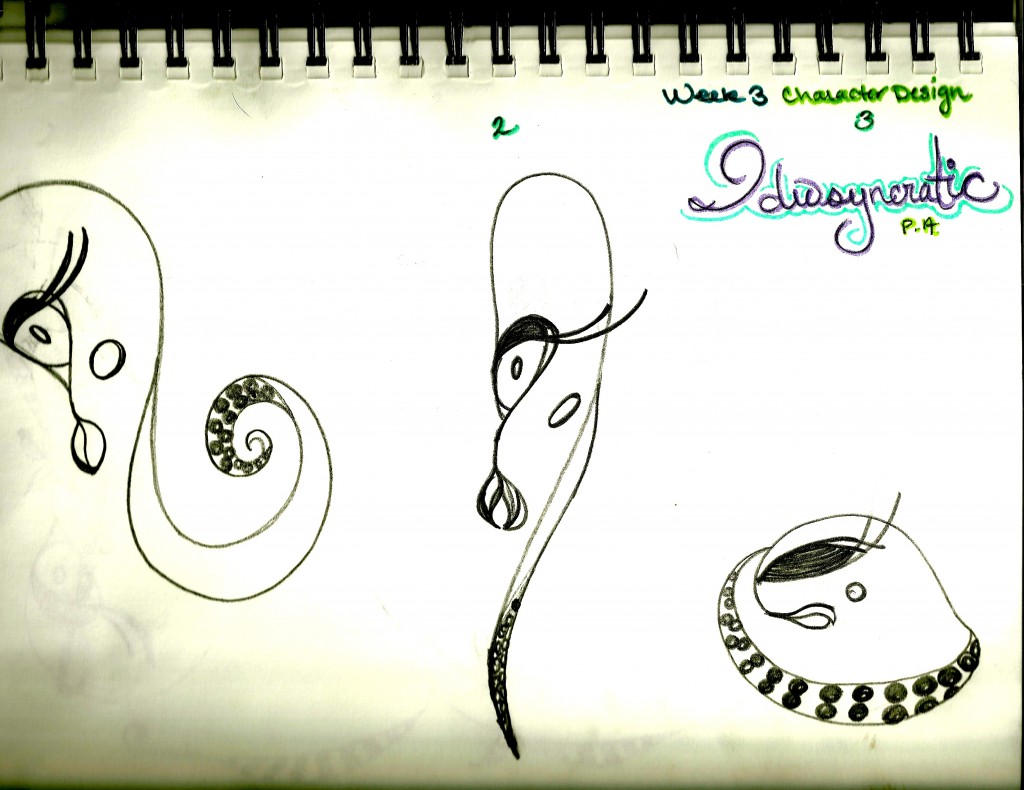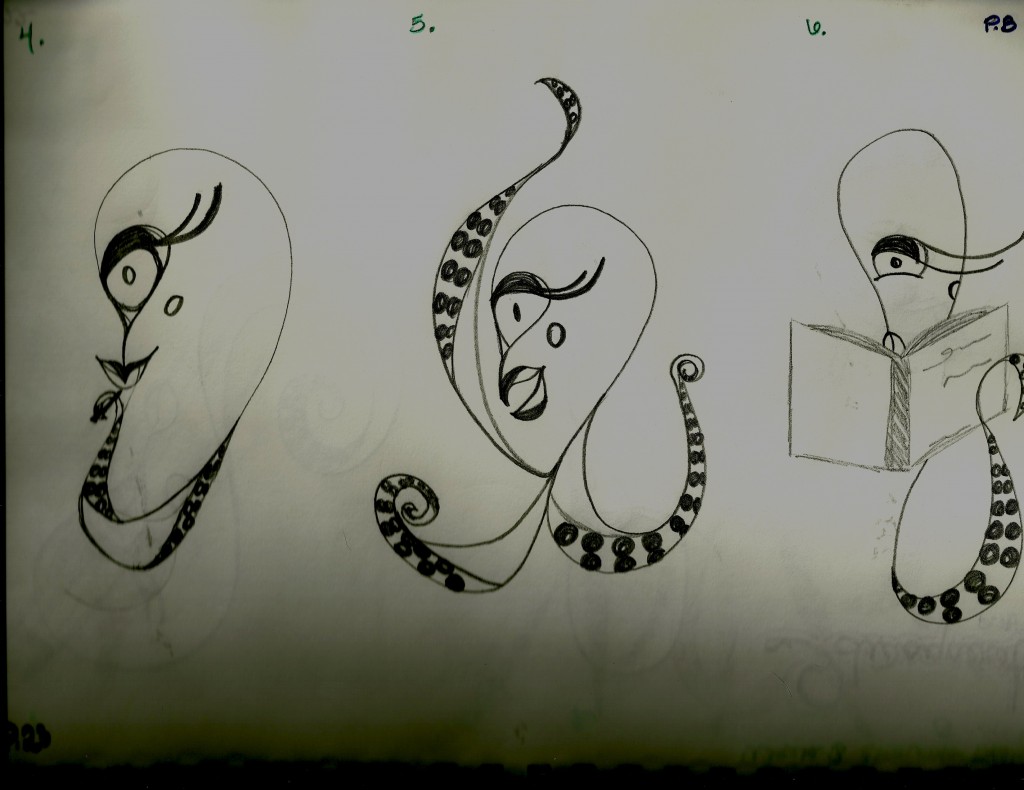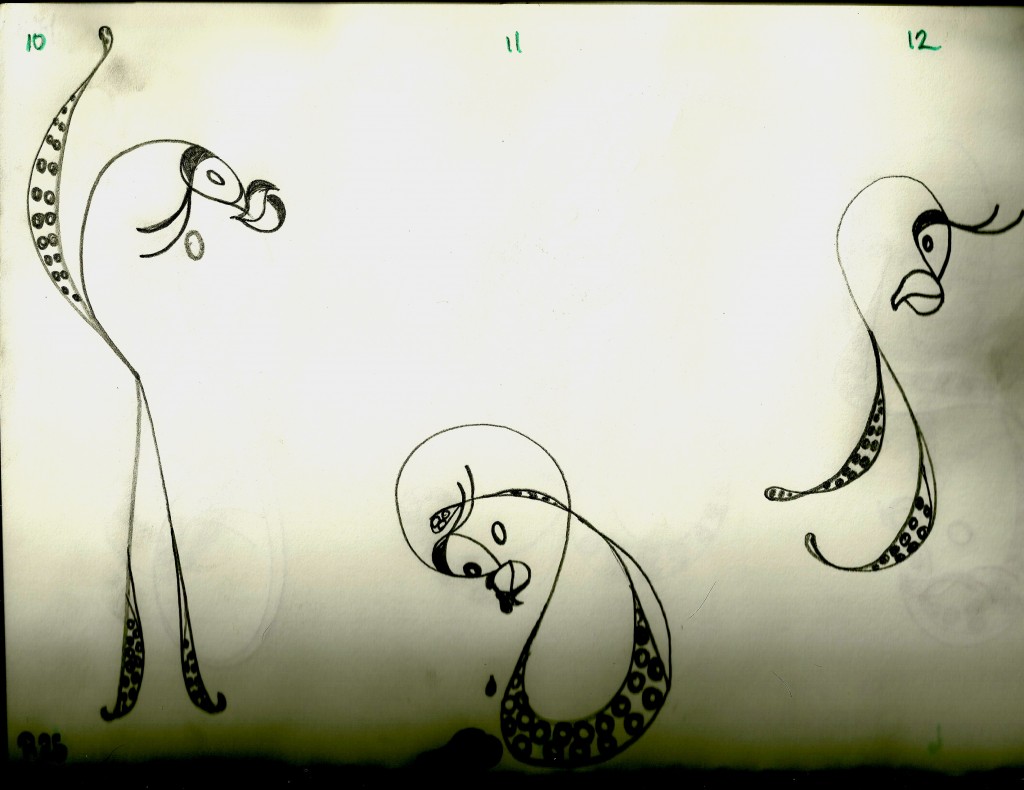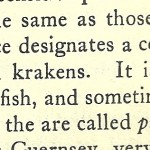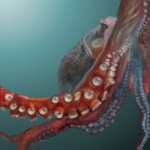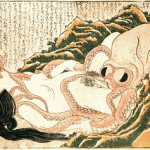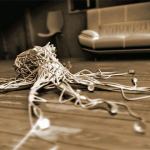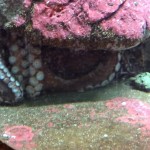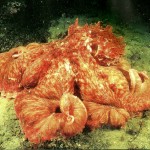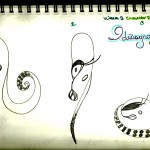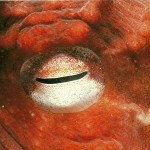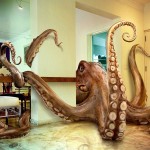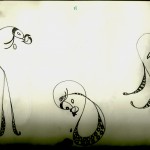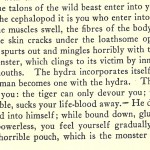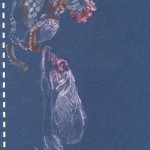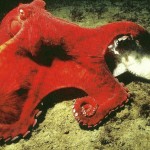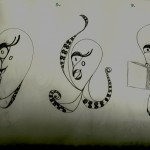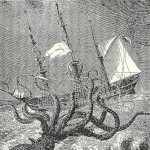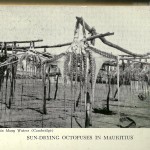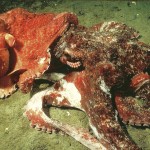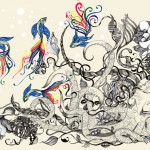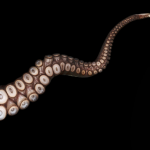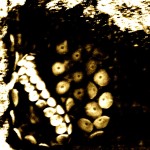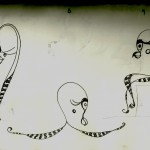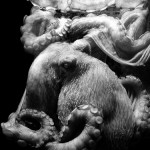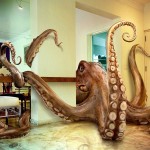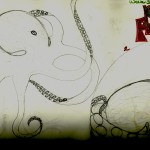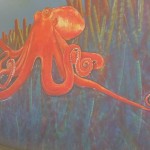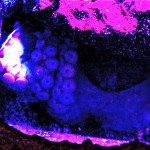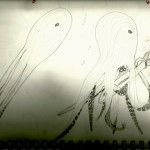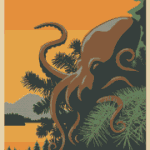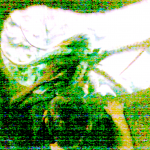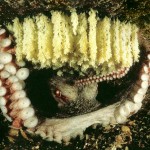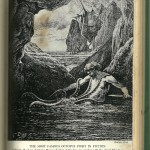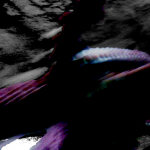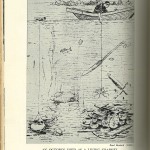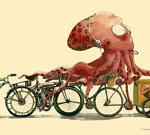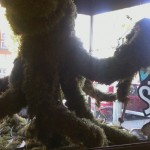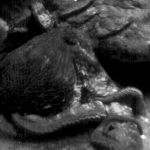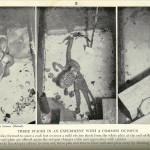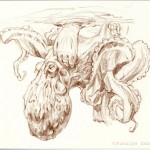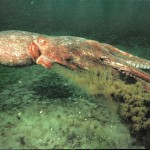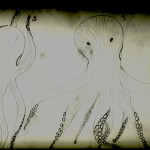also referred to as GPO
Enteroctopus dofieini
Kingdom: Animalia
Phylum: Mollusca
Class: Cephalopda
Order: Octopda
Family: Octopodidae
Genus: Enteroctopus
Species E. dofieni
Photo by Wihopa Win
Introduction
For seven weeks I will be visiting the Point Defiance zoo and aquarium in Tacoma, Washington to study, observe and deepen my understanding of animals by spending at least three hours a week with Noodle; she is commonly known as: a Giant Pacific Octopus, GPO for short. Her tank is in the Tacoma Narrows exhibit of the aquarium.
These few weeks of time with her are the beginnings of our relationship and my education of GPOs. During this time I will have no direct interaction with her, although I will be observing from outside her tank where it is possible she may notice me and/or begin to recognize my weekly presence. She is the only octopus in her tank but is accompanied by other sea creatures, they include sea cucumbers and sea anemones. I will be observing the interactions of other zoo visitors. I am interested in studying Noodle because octopuses are commonly under appreciated as remarkable creatures and have been cast with a wicked reputation in which I would like to dismantle.
Photo by Wihopa Win
Natural History
Giant Pacific octopuses are apart of the cephalopod class, cephalopod means “head footed.” They originated 600 million years ago. The GPO lives in the North Pacific Waters, along the coasts of California to Alaska, Bering Sea, Russia to northern Japan. They inhabit dens in shallow and coastal waters up to 1,500 meters deep, which consist of any crevice large enough for their beak to fit into, such as rock crevices, shipwrecks, shells, kelp hold-fasts, bottles, bridges, concrete anchors, etc. 65 Million years ago octopuses moved to living in dens when the species evolved out of the protection of a shell. They move into new dens regularly and it is not common for them to remain in the same den for longer than a month. Octopuses are meticulous about their living conditions and elaborately clean and modify their dens. Most often the dens will have a back door or a multiple of entrances. They have even been known to reconstruct their den. Most often they share living quarters with fish, crabs, snails, clams and other fish and invertebrates. The GPO is known for eating all of it’s living-mates in which case the octopus will then relocate.
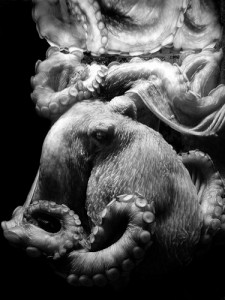
“At the Seattle Aquarium a few years ago, a large female Giant Pacific octopus on public display chose to live behind a fiberglass backdrop at the rear of the tank. She had squeezed through a 2 inch opening at the bottom of the backdrop and into the 3 inch wide space behind it. It was fascinating to see this 30-lb. octopus jammed almost flat into such a restricted, 1-yd.-by-2yd. space.” pg. 69 Mather.
Two kinds of movement:
–control and coordination: directing the arms
“Octopuses have circular muscles around the outside, radial ones from the center to the periphery, and transverse ones spiraling around the length in left-
hand or right-hand coils.” pg.82 Mather
–locomotion: movement in their environment at a speed of 1foot per second.
Propelling water jets through their funnel.
Functions:
–Arms: More than half of body volume and neurons, programed outside of the brain.
Each arm has a chain of ganglia or nerve cord
Resist a pull of 100 times their body weight.
Detached arms can function and grab onto objects, they are able to be re-
grown.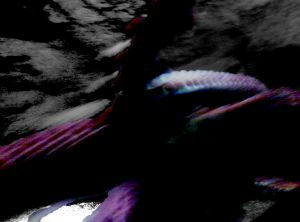
–Suction cups: Each arm contains about 250 cups from center to tip.
Below the nerve cord is the sucker ganglia.
Provides them with taste.
Have local control and the muscle structure provides a contour to object.
–Mantle: Serves as a body and head.
Contains all organs and brain.
The octopus has three hearts, two for the gills and one for the entire body.
Diet
GPOs primarily eat shrimp, crabs, scallops, abalone, clams and fish. They will sometimes eat dead animals such as sharks. There has been recorded cases where an octopus has nabbed and consumed a seagull or wrestled down a live shark. An example of this occurred at the Seattle Aquarium. GPO’s eat most animals they feel confident to hunt. Most hunting is done at night, octopuses are nocturnal, they feed four to five times per week. 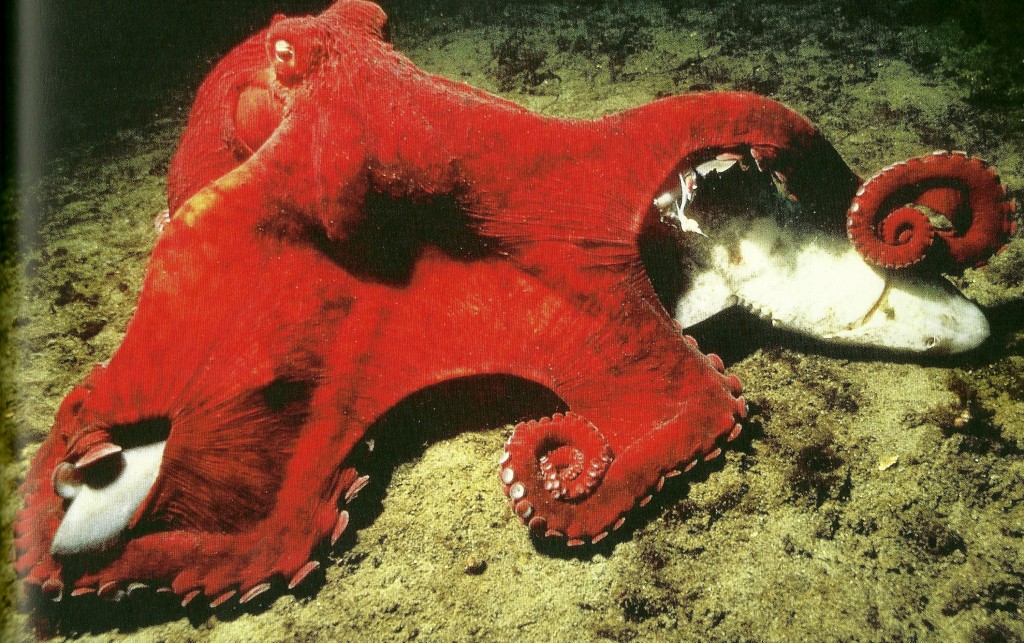
Photo by Fred Bavendam
–Obtaining prey: There are multiple ways.
1: Creates a web to trap it’s prey.
2: Arms and suctions to pry open shells and bring food it’s mouth.
3: A beak located directly inside it’s mouth.
4: Radula, a barbed tongue, is used to scrape the animal out of it’s shell.
5: Salivary Papilla is used to drill into shells.
6: Papilla’s secretion erodes and weakens prey.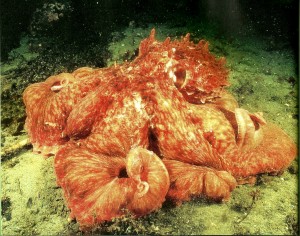
Photo by Fred Bavendam
Predators:
Always on the look out for harbor seal, sperm whale, sea otter and humans.
-Defenses:
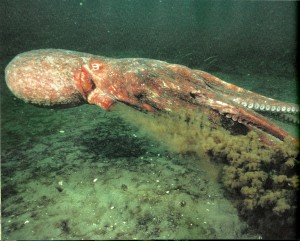 –Jetting water: gives the octopus speed to escape, speeds up to 25mph. Used to blow things away.
–Jetting water: gives the octopus speed to escape, speeds up to 25mph. Used to blow things away.
–Inking: the ink contains tyrosinase which is a compound that impairs smell, taste and vision of the approaching predator.
–Arm strength: the GPO is able to resist the pull of 100 times their body weight.
–Beak: sharp and retractable similar to a parrots beak.
Photo by Fred Bavendam/Minden Pictures
–Color-changing: Thousands of chromatophores make up the octopuses skin, each chromatophore contains multiple sacs of color. Muscles surround the chromatophore allowing for each one to be independently controlled in pigment.
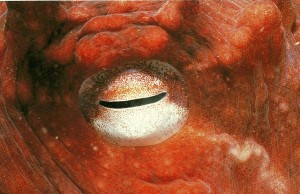 Photo By Jeffrey L. Rotman
Photo By Jeffrey L. Rotman
–Physical illusions: Slit pupil is to appear as an extended line rather than an eye to predators. Skin Papilae above the eyes are raised is also used to breakup eye recognition. Four of the nine chromatophores made up for the color patterns come to the eye area. The body is as well covered with papilae that rise to further camouflage the GPO with its surroundings.
Reproduction:
–Mating: Giant Pacific octopuses live for 3-5 years. Females are generally larger in size. Reproduction is the final stage of their life cycle. Since GPO’s are solitary, males locate a female to mate with by sight, chemical attractants and visiting previously occupied dens. It is common for a male to wait outside a females den, usually the largest male is first in line, and sometimes two or three smaller males will wait after him; each five to six feet apart.
Males have a modified arm known as a hectocotylus, which has a spoon like tip, this arm stores sperm. When a male approaches a female he will show his underside to identify to his sex. Sex is also recognized by chemical receptors. He will then continue in a decorative display of coloration. If the female accepts the elaborate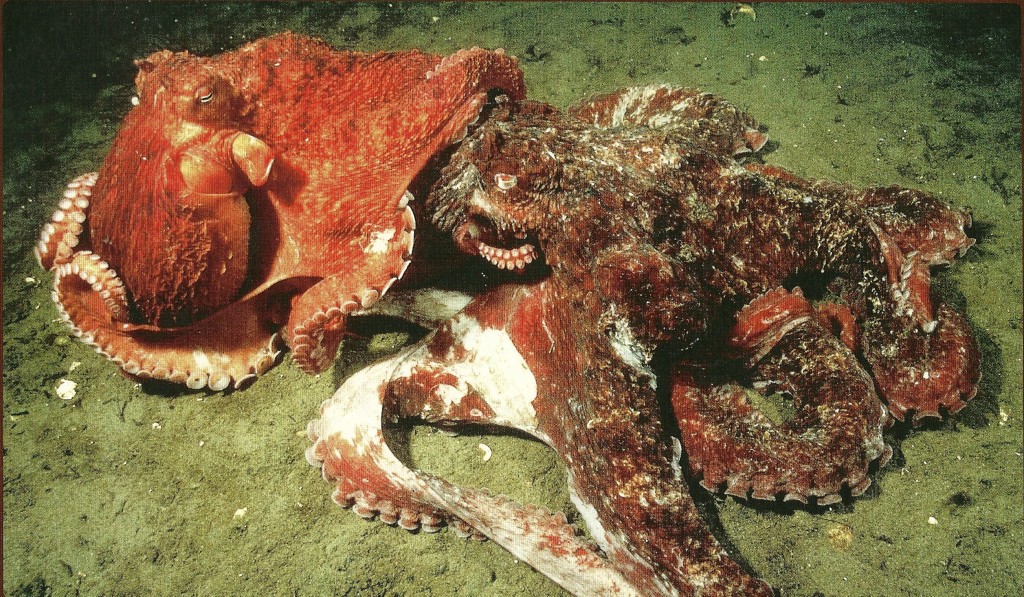 display of colors carried out by
display of colors carried out by
Photo by Fred Bavendam
the male will stroke her head and abdomen; they will intertwine arms mating for at least one hour and often times more than two. The male during this time will insert his hectocotylus into the females mantle and release his spermatophores, which are three feet in structure. After mating the males going into a state of senescence, which is similar to human dementia or Alzheimer’s. They go crazy, stop eating, roam about aimlessly and live without the protection of their den. Immune systems shut down and slowly dieing until eaten occurs.
–Eggs: After mating the female lives regularly until she chooses to lay her egg. The eggs remain in her mantle fertilized until she is ready, then she will retreat to her den and remain there for the duration of her life. Once this occurs she then goes into senescence. Her eggs hang from the ceiling of her den, up to 100,000 glass-like beads dangle. She intensively cares for them, cleaning them regularly by blowing filtered water on them. It could take six months or longer before the eggs will hatch. In the meantime the 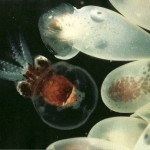 female will not leave h
female will not leave h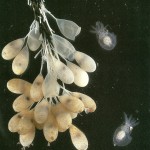 er den or eat. She metabolizes up to 70 percent of her body weight. The baby GPOs are the size of a grain of rice when hatching. Only 2 of 57,000 will fully reach maturity. After the eggs hatch the mother leaves the den to die.
er den or eat. She metabolizes up to 70 percent of her body weight. The baby GPOs are the size of a grain of rice when hatching. Only 2 of 57,000 will fully reach maturity. After the eggs hatch the mother leaves the den to die.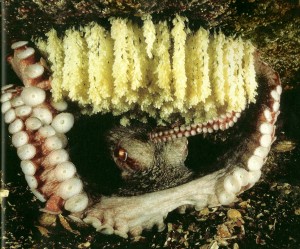
Left and Center Photo by Fred Bavendam
Top Right by Jeffrey L. Rotman
Behavior:
Intelligence:
The GPO has a very large brain in comparison to other animals, it the size of a walnut while dogs are the size of a grape and cats are the size of a pea, they are able to learn and train through conditioning. Laboratory and zoo octopuses have been able to learn how to paint, run mazes, solve puzzles, recognize objects and individuals and have been known to outsmart the scientists. “One octopus used to sneak out of its aquarium tank each night, crawl into nearby tanks to eat fish, and then return to its own tank before the researchers arrived back at work the next morning.” pg34, Cerullo. Not only are octopuses able to train with researchers they learn from observing each other. There have been studies done where trained octopuses will preform for untrained octopuses is adjacent tanks, they repeated their performances four times. When the untrained octopuses were tested researchers found that not only could the octopuses do the identical task, they did them faster and with fewer mistakes than the trained ones.
“The Giant Pacific Octopus engages in REM sleep and shows brainwave patterns during sleep which suggest that these animals may have the ability to dream. They may even posses consciousness.” Octopuses can also be hypnotized which also indicates the existence of a conscious.
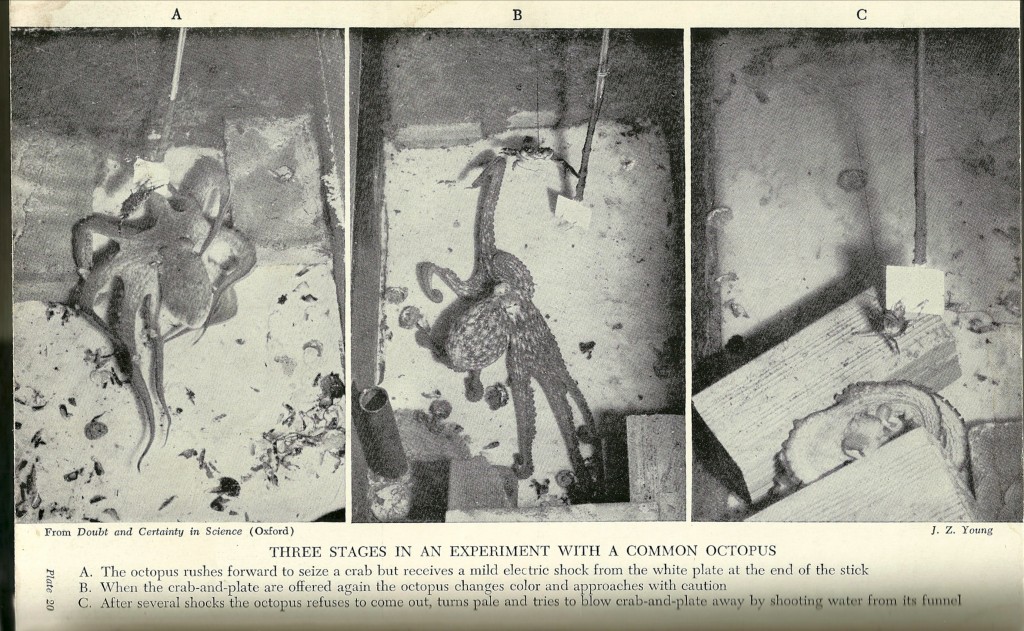 The above image shows the learned conditioning of an octopus. A reads: The octopus rushes forward to seize a crab but receives a mild electric shock from the white plate at the end of the stick. B reads: When the crab-and-plate are offered again the octopus changes color and approaches with caution. C reads: After several shocks the octopus refuses to come out, turns pale and tries to blow crab-and-plate away by shooting water from its funnel.
The above image shows the learned conditioning of an octopus. A reads: The octopus rushes forward to seize a crab but receives a mild electric shock from the white plate at the end of the stick. B reads: When the crab-and-plate are offered again the octopus changes color and approaches with caution. C reads: After several shocks the octopus refuses to come out, turns pale and tries to blow crab-and-plate away by shooting water from its funnel.
In captivity Giant Pacific octopuses enjoy interactions with humans, they recognize their caretakers and rise to the surface of their tanks and greet them. Noodles works with her aquarist on the left side of her tank, he trains her through positive reinforcement conditioning.
Watch GPO’s interact with humans….
Personalities:
In most of my research I have found that GPO’s have personalities. “Some behaviorists call such labels anthropomorphic, while others contend that it’s anthropocentric to presume other animals cannot have personalities.”The study of octopuses and their personalities has widened the scope of study simply because they 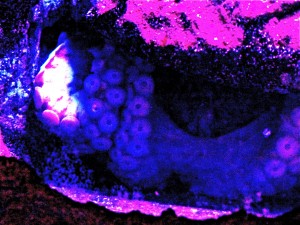 are solitary animals and previously animals with personalities were attributed to social structures within a species. While I was discussing Noodles with her trainer he told me that she was shyer than his latest octopus Rocky.
are solitary animals and previously animals with personalities were attributed to social structures within a species. While I was discussing Noodles with her trainer he told me that she was shyer than his latest octopus Rocky.
Photo by wihopa win
Human Use of the Octopus
Humans have used octopuses in various ways and sometimes unexpected way since ancient times. 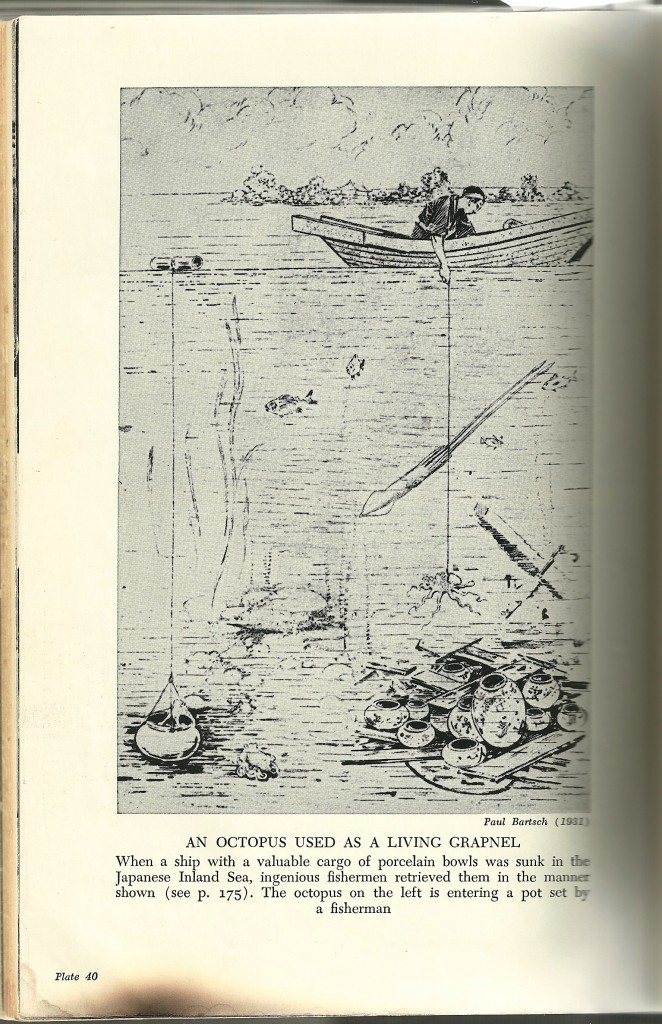
Photo by Paul Bartsch
-Salvage from sea floors
-Fossils used to located oil and coal deposits.
-Medical research
-Sepia ink
-Eyes made into ornaments.
-Examples to develop new camera lenses.
-As food or bate to get food
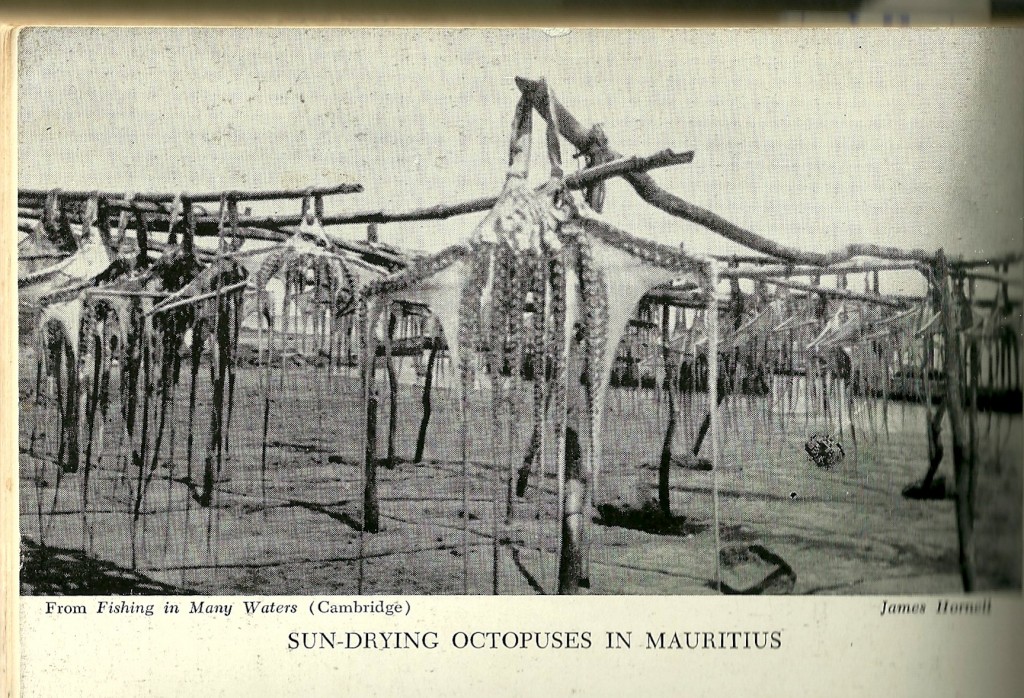 Photo by James
Photo by James
Cultural History:
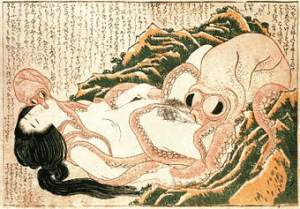 Photo by Hokusai
Photo by Hokusai
Myths: Throughout history Giant Pacific octopuses have been represented in various ways. Typically in the finishing of all stories the octopus retreats back to it’s den deep within the sea, taking it’s prized human. The above picture is of a Japanese myth Tako to ama, or The Dream of the Fisherman’s Wife painted by Hokusai on woodblock. This myth was part of a collection of shunga erotic prints fist published in 1814.”The Dream of the Fisherman’s Wife is often cited as an early forerunner of tentacle erotica, a motif that has been common in modern Japanese animation and manga since the late 20th century.”
Giant Pacific octopuses have been in Native American story telling as well. Haida have a story called The Devil-fish’s Daughter. One day a shaman is searching for the Devil-fish’s den at low tide so that he can kill her, instead she surprises him and drags him into the depths of the den where she lives, her father is Chief of the Devil-fish. He marries the Chief daughter. After many years he becomes home sick and returns to visit his family. While there the Devil-fish’s daughter and the man where there she longed for her water world. One day the couple began to melt and fell through the crack of the floor board, returning to the realm of the Devil-fish. Another is Raven Annoys Octopus, in this story Octopus teaches Raven not to bother her.
Most myths and stories depict the octopus a horrific threat to life such as in the Victor Hugo’s Toilers of the Sea. It is one of the most famous octopus fights in fiction. Below are some examples of text in which humanity have given a narrative for GPO.
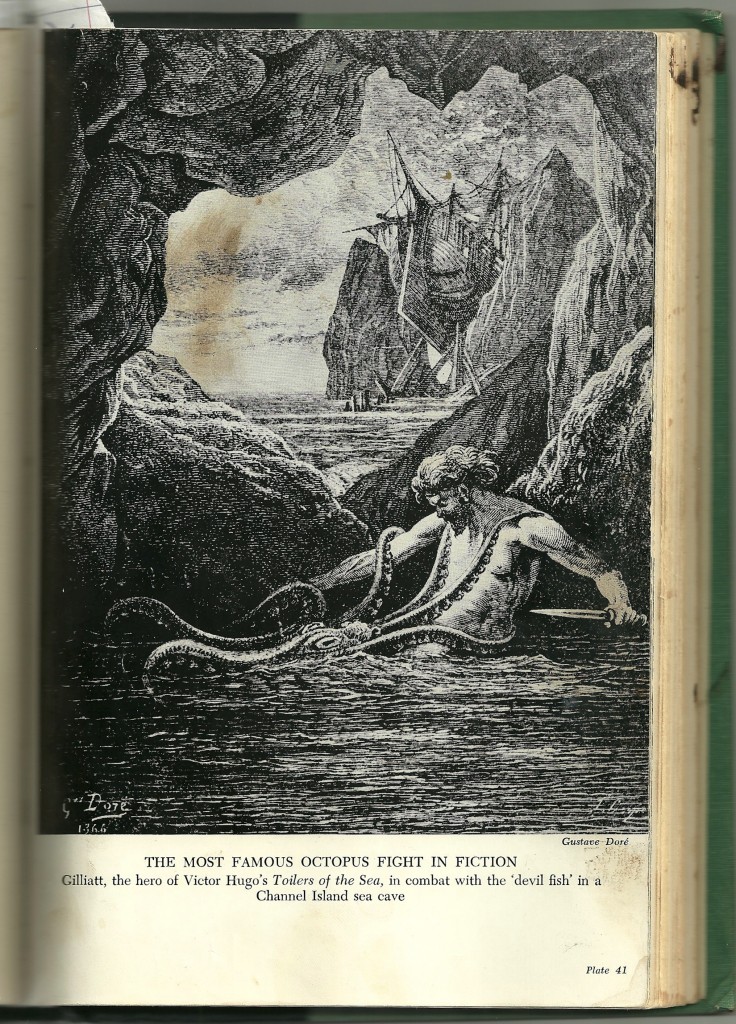 The Octopus is described as…..
The Octopus is described as…..
Another myth of the Giant Pacific octopus is of the Pacific Northwest Tree octo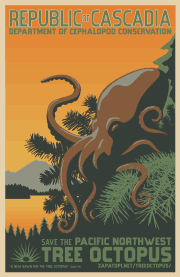 pus. Much like the myth of Sasquatch this octopus appears to be exactly like the GPO. This octopus was a complete invention 1998, but has been very popular and people still seem to get hoaxed by it. In fact you can watch a youtube video of the octopus….What do you think?
pus. Much like the myth of Sasquatch this octopus appears to be exactly like the GPO. This octopus was a complete invention 1998, but has been very popular and people still seem to get hoaxed by it. In fact you can watch a youtube video of the octopus….What do you think?
Personal Gatherings
My understanding and opinion of the GPO is quite different. Through my observations and studies of these animals I have grown to admire them.
Observations:
Photo by Wihopa Win
Below I have included a couple of my weekly observation sessions. My reflections of these observations follow.
Observation Notes Week 2 : Sunday
12:00pm: Arrived
She is in her den. I am able to see one eye and at least two arms. At the right end of her body she is dangling and twisting something, it looks like the end of her tentacle but is a darker shade of red. Her body is a red and white, the red is slightly translucent looking. Her suckers are waving.
12:15 Her eye is getting larger, she may be waking up. It seems as if her eyes are open completely. Her body remains in the same position. She is resting very stilly. Her tank is roughly ten feet long in the horizontal position and roughly four to five feet in height. I am not aware of the width of her tank due to the distortion in water but I would guess it to be around three to four feet wide. Her den is located in the back left corner on the floor. There is a rock on the floor positioned some what centrally. On the rock is a white sea anemone. The walls are of red rock, at the corner of the front right side the rock bows out and leaves a front nook from floor to water surface. There is another sea anemone on the left wall. There is a sea cucumber in the right front nook and on the back wall near the right side.
1:07 She has not moved her position. She is resting. Her color has changed, she has gotten redder and back to white with tints of red and then back to a deep red. I have notice her change in color when high voices of children are around. I am not sure if she is able to hear them, or if the “reaction” is a coincidence but the pattern I have noticed. Her change in color while children’s voices are present, but the child isn’t always at her tank, has occurred more than five times now.
Some one flashed their camera and I was able to look deeper into her eye. It is incredible! The color is a metallic gold/ yellow possibly even a faint tint of green. Her retina is a rectangular shape and is horizontally across her whole eye. The size of her eye is retractable. When she is sleeping it is quite small but some color is still visible. When her eye is completely open is it roughly the size of a quarter. It has a glowing quality to it.
1:11 She is moving slightly, her arms. Her, what I think is breathing or filtering of water, is getting more emphasized. The vent is gaping more. I will do more research on how this works. I am able to see the waving darker red end of her tentacle. I wonder why she waves this one arm around?
Many viewers find her not interesting, she is called “boring.” I have heard comments such as, “Did you know that octopuses are really really smart.” I was very excited to hear this!
1:43 She has been sleeping for a while. None of the other creatures have moved. Her breathing is very regular and her eye is small but visible. One of her suckers may be shedding, I see a translucent skin-like particle floating, but attached, near her arm.
2:00 I am going to leave for an hour and return to notice differences.
2:30 I have returned. She is still sleeping, same position. The sea cucumbers have moved and the gold sea anemones are erect. Her head is faced to the right of her den and is horizontally parallel to me. Arms are wrapped around body and head on the left and right sides. Her breathing is deep, her valves blubber which was not happening before. It is like a balloon deflating and the end is flapping.
3:15 She is still sleeping. Her legs have moved position slightly. The tank looks as it had before.
3:30 Sleeping. I am headed home.
Reflection Writing Week 2
Week one observations were very stimulating. Her movements may be slight but I found bursts of excitement within myself when the seldom actions happened. I selected this animals because I am aware that they are very smart, I questioned myself if I would be able to recognize or observe their intelligence. Also, I feel they are overlooked, in part because they are so un-relatable for humans (so mainstreams assume) and possibly due to their uncommon appearances. People are afraid of the unknown or what they do not understand. Often times octopuses are portrayed as evil or “devil-fish,” sucking lives down to the dark deep, I believe contrast to this; it my goal to make this opposition visible. A hunch I have is that octopuses are gentle, dancers of the sea whose intelligence is impressive. I can see a spirit within them. From what I observed today I could say she holds no threat. I am saddened for her, I wonder if her tank was more spacious and inviting for adventure if she would? I cannot imagine that her tank is larger than the stretch of her body. I wonder if she is happy? Does she enjoy visitors? Will she recognize me, appreciate me or be bothered by me? I also wonder if she can hear through the glass, or what she sees? From my conclusions, I think she is board with her life. It is possible I am projecting this thought/ feeling upon her but when I look into her eyes I feel it. Maybe the zoo setting is giving this to me. I wonder what she would be like if she was in the large tank with all the other North Pacific sea life? The flightiness of her red arm is encouraging. I think it shows personality. It is sensual, persuasive and rhythmic. I wonder what the waving of this arm means, if it has a meaning? I think she needs a new name, she is far more spectacular that Noodle.
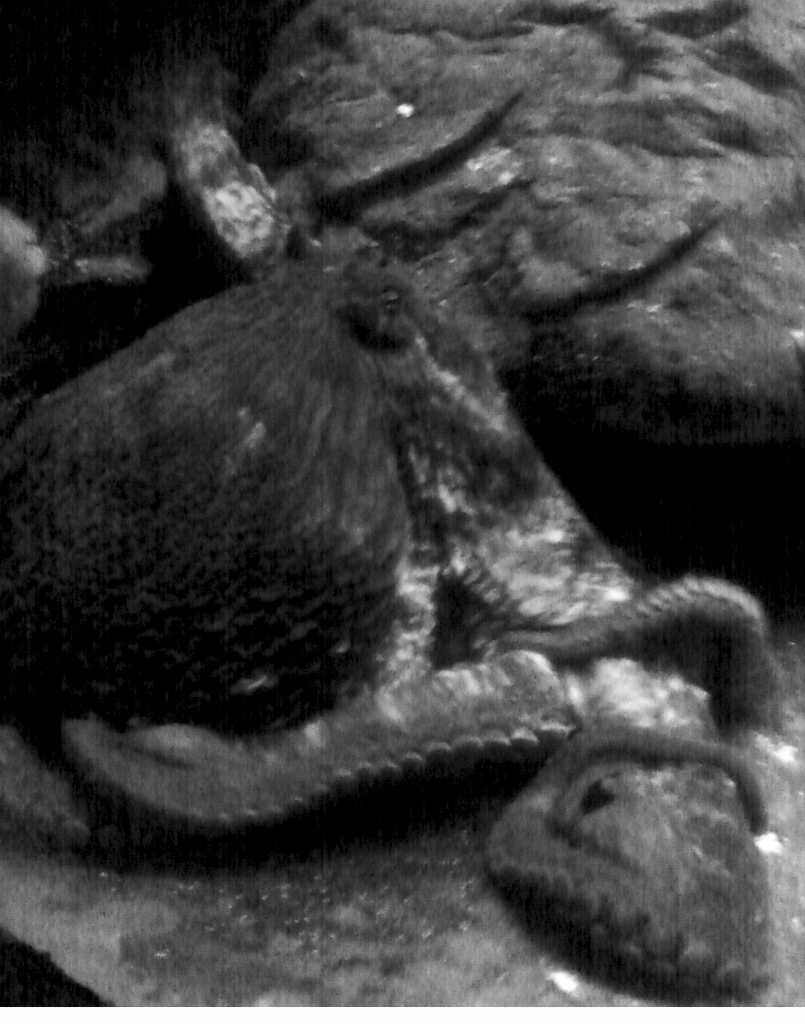 Photo by Wihopa Win
Photo by Wihopa Win
Observation Notes Week 4 : Saturday
11:30 I arrive. She is shifting a lot right now. Switching her body position from right to left and back again, about two or three times. This is done in a rotation, like turning your head. Her arms move slightly, but remain their main positions. The tank looks murky. There are two large particles on the floor near the back center of the tank, slightly under the overlay of the right side of her den. I see a red/orange ball in the back right conner tucked by a gold sea anemone.
12:04 She moved from left to right. I see three arms curled up around her. She is a deep red color splotched with white. One eye is visible.
12:09 Moved her suckers, she has tucked her body into the den more. Her color is very red, a deep red. I see the red waving arm again. I am not able to see suckers on it (which would mean the octopus is a male, but a caretaker told me she was female). She is waving this arm about, like a cat’s tale.
There is a new sea creature in the tank. Long and white with stripes. I would guess five to six inches long. At one end there is a flower-like top. I do not know what creature this is. The particles I see look similar to this creature. There is a sea cucumber near the octopuses left side, about four inches away.
12:30 I am going to the exhibit to the right to observe the red octopus. She can get up to five inches wide. She is latched to the wall, her eyes are shut, she is sleeping. I see seven arms, five are attached to the wall at some point and two are free flowing. Each arm is curled up at the end. Her eye is raised up from her body, there is a three leaf skin design attached to the bottom of her eye. Her body is a deep red, almost tints of purple. Her body is covered with cone like shapes, or soft spikes.
12:33 She opened her eye, moved down the wall behind rocks in the back of her tank. She moved to the back right corner. Her tank is roughly 16 inches by 12 inches by 12 inches. She has crawled up the rock and it facing me. There are spike like shapes on top of each eye. Her eyes are about the circumference of a dime, they look like raspberries on top of her body.
12:40 Moved to the corner wall again. She moves weightlessly.
12:51 She went behind rock. The tank has seven rocks in it and a broken glass bottle. The floor is sand.
12:54 Bubbles came up from where she is resting. There is one red starfish and five snails.
12:56 Another bubble.
1:00 She came up, just her head. Popped back down behind the rock and is moving herself to the left.
1:07 She is really active. Moving her self all around the tank. She changed to camouflage with the rock. Her colors are move defined areas of change. There is a basic deep red color and then particular ares change from red to white. Her ventricle is fully visible. It is retracting and expanding, looks like a sea anemone. When it is fully retracted the top folds in and it looks sealed for a second. Three viewers have pasted without noticing her head peaking out.
1:12 She has stayed in her camouflage color and position.
1:16 Her head shrank in then popped back up. She is slowly moving along the sand to the right. Her legs curl, twist, slither, suction and pull her around.
1:30 Asleep. Wedged between a rock in the back right corner. I can see two legs and one of her eyes. Many people when they notice her, think she is a baby or squid, they do not bother reading her information about her.
1:30 Going to check in with Noodles. Laying in the same position with her body and legs. The sea cucumber has moved down on the floor half way. i am able to see the red end leg twisting around. Her color is very white and light red. Her breathing is slow, not much movement with ventricle. I think she is asleep.
1:35 Back with red. She is swiveling her legs and now has gone to the corner, propped her head up and is camouflaging herself. The white areas are in and out from white to red and white again. Crawled on the floor to the opposite back corner. Propelled to the upper right corner and clung herself to the wall. She then moved back to the bottom left corner. She is repeating this path of action.
1:40 Settled behind the rocks. She is not visible.
1:50 Check in with Noodle. Her color is much deeper in red. Her marbled pattern is visible. She is rotating her eyes, facing forward and then back again. She is moving her body up and back into a horizontal or parallel position to me.
1:55 She has rotated herself, I cannot see her eye from standing, it is hidden by the den’s edge. I came closer to the tank and she squeezed her body in. Her suctions are touching the sea cucumber. She is a light white color. She flinched- new people came up to the window. She is shifting completely. Rotated her back to me, she is more exposed than ever. I see two ventricles.
2:00 She came completely out and turned around and went back in. Her color just deepened. I see both valves working. Her arms were still curled up and close to her body.
2:05 She got red and moved her two exposed left legs. She is suctioning them to the wall. She is slowly edging her direction to the left side of the den, exposing her body more. She rotated to the right. Came out completely and is venturing around. She is displaying her under on the window and swimming from wall to wall.
2:22 Went back into den after 20 minutes of being in the open. Her colors are adjusting. I can observe her valves working symbiotically. I think I can see a shedding from a sucker floating.
2:26 She is coming out again. She came to the class. Her body is pressed against the glass. There is a circle on her back end that is all white and not made of the outer layer. I need to research what this might be. It is about 3 inches in diameter. She has two spike like shapes on top of her eyes. She is red/orange. She frequently spreads herself out in a star like shape, umbrella like. The tank is to small for her to fully stretch out, her arms reach from wall to wall. She particularly is spending her time on the glass. Her head close to the glass crawling along or hovering fanned out. She displayed her underside, I was able to see all her suctions, but not the center of her. She looks smaller than I imagined when she was wrapped in herself. Her body is roughly the size of a beach ball.
2:39 She is still swimming around
3:00 I am leaving to go home.
Reflective Writing Week 4
WOW! This week was the most stimulating three hours yet! Noodles revealed herself. It was a spectacular display, I looked into her eyes, only glass between us. I was inches away. She is incredible, angelic, so sweet. She appears to be curious, it seemed like she was attempting to touch me through the glass. Was she approaching me the others near the glass? She paced the front, from left to right and back and forth. Her arms leading her direction, attaching, slinking, detaching and repeating to move forward. She spread herself open, floating, head against the glass wall. Suspended, wide open, the light illuminated the stretchy skin between her arms. She was blossoming. I was able to observe two octopuses, this was a great opportunity because the little Red octopus was able to swim in her tank. This allowed for me to view and learn about this movement since Noodles does not have the room for this in her tank. I am surprised with how restless she is in comparison to Noodles. Why is this? I love the way they move, it is so very sensual, as if each arm is embracing all that it touches. To investigate, map the ways she will go, has gone. I think these creatures are very spiritual animals. I am speechless about today. I feel as if I know nothing nor understand anything about this remarkable creature, I believe this because I am lost on how to describe the sensations put upon me. Does anyone honestly know?
Representations of The Giant Pacific Octopus in My Town
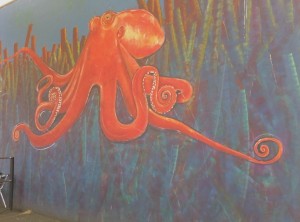 Painted on the outside of the local beer brewery, the vibrant and large GPO represents the Northwest.
Painted on the outside of the local beer brewery, the vibrant and large GPO represents the Northwest.
Photo by Wihopa Win
Inside a 4t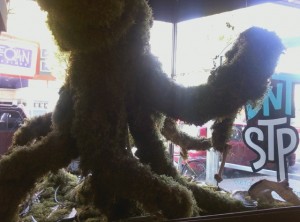 h ave. shop a mossy octopus creates attraction in the display window.
h ave. shop a mossy octopus creates attraction in the display window.
Photo By wihopa win
Creative Writing
Three Part Invention:
Feminine, functions of curves.
Passion, color meant for devotion, Red.
Gentle, suctions caress.
Swivel, Swoop, Sway.
Dance, Dart, Dabble.
Open, Observe, Orchestrate.
Flirt, she is persuasive, motions to draw inquiries.
Passive, gaze into a mystical.
Shifts into surrounding stone, granite, slate, agate, skin of marble.
———————————————-
I dance with the fluidity of eight legs.
Finesse, she will move you.
A suction of my heart, the cold window creates too much separation.
Locked, eye to eye, intangible but connected.
———————————————–
Water break our wall, water rise, water fill my lungs.
A giver, a spare ventricle: I breath in water, I release air.
Together.
Swivel, Swoop, Sway.
Dance, Dart, Dabble.
Open, Observe, Orchestrate.
Together we create.
Water fall, water fill.
Promised, a ventricle, she and I hope to move you.
Animation Work:
Pure Animal
Puppet:
Drawing:
Bibliography:
Cerullo, Mary M.. The Octopus: Phantom of the Sea. Dutton: Cobblehill Books, 1997. Print.
Lane, Frank Walter. Kingdom of the octopus: the life history of the Cephalogoda. New York: Sheridan House, 1960. Print.
Markle, Sandra. Animal Prey: Octopuses. Minneapolis: Lerner Publications Company, 2007. Print.
Mather, Jennifer A., Roland C. Anderson, and James B. Wood. Octopus: The Ocean’s Intelligent Invertebrate. Portland: Timber Press, Inc., 2010. Print
Moynihan, Martin. Communication and Noncommunication by Cephalopods. Bloomington: Indiana University Press, 1985. Print


